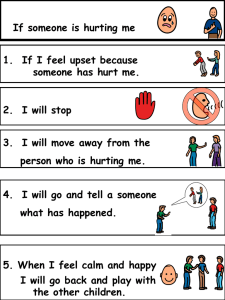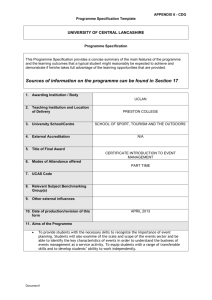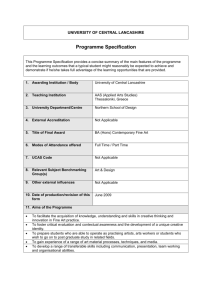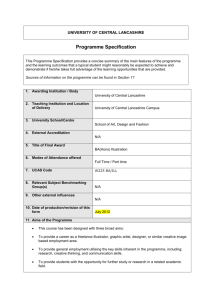MA Toy Design (Sept 2014) - University of Central Lancashire
advertisement
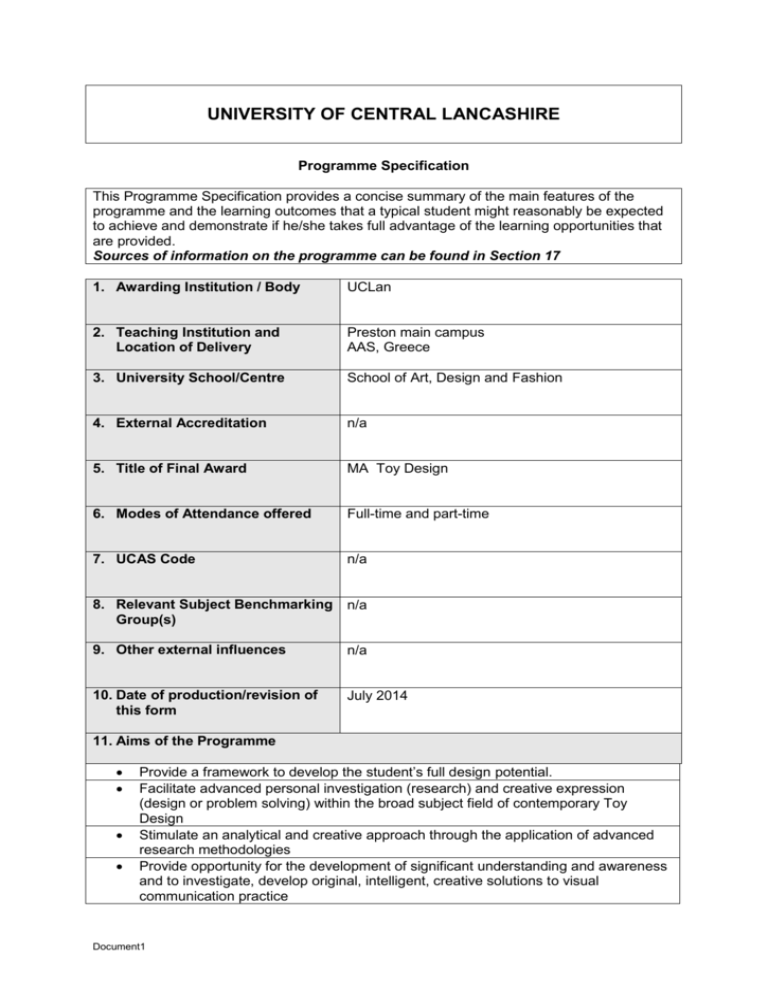
UNIVERSITY OF CENTRAL LANCASHIRE Programme Specification This Programme Specification provides a concise summary of the main features of the programme and the learning outcomes that a typical student might reasonably be expected to achieve and demonstrate if he/she takes full advantage of the learning opportunities that are provided. Sources of information on the programme can be found in Section 17 1. Awarding Institution / Body UCLan 2. Teaching Institution and Location of Delivery Preston main campus AAS, Greece 3. University School/Centre School of Art, Design and Fashion 4. External Accreditation n/a 5. Title of Final Award MA Toy Design 6. Modes of Attendance offered Full-time and part-time 7. UCAS Code n/a 8. Relevant Subject Benchmarking Group(s) n/a 9. Other external influences n/a 10. Date of production/revision of this form July 2014 11. Aims of the Programme Provide a framework to develop the student’s full design potential. Facilitate advanced personal investigation (research) and creative expression (design or problem solving) within the broad subject field of contemporary Toy Design Stimulate an analytical and creative approach through the application of advanced research methodologies Provide opportunity for the development of significant understanding and awareness and to investigate, develop original, intelligent, creative solutions to visual communication practice Document1 Challenge students to take a critical position in relation to existing theories and generate new connections within the field of contemporary Toy Design and challenge traditional design boundaries 12. Learning Outcomes, Teaching, Learning and Assessment Methods A. Knowledge and Understanding A1. Formulate appropriate questions related to chosen design discipline that expands the boundaries of contemporary art and design practice. (DE4107) A2. Provide evidence of an awareness of a range of contemporary practitioners, their works and their working methodologies. (DE4201) A3. Articulate an appreciation of current critical thinking within their own design discipline and demonstrate an ability to create new and unique connections and associations in relation to their personal practice. (DE4201) A4. Articulate independent viewpoints, critically interpret and clearly justify relevant arguments.(DE4326) Teaching and Learning Methods Lectures, seminars and tutorials External visits Assessment methods Written course work, including learning agreement and position of Practice Report B. Subject-specific skills B1. Research, reflect upon and define a specialist line(s) of enquiry to investigate.(DE4107) B2. Generate initial practical studies. (DE4107) B3. Demonstrate, through design ideas, a capacity to expand accepted creative practice norms. (DE4108) B4. Articulate an appreciation of current critical thinking within their own design discipline and demonstrate an ability to create new and unique connections and associations in relation to their personal practice. (DE4201) B5. Produce a body of work that indicates a highly personal statement, contributing to the wider debate current in the chosen specific design discipline. (DE4326) B6. Work independently to produce a cohesive body of design work that reflects professional standards within their field of study (DE4326) Teaching and Learning Methods Lectures, seminars and tutorials Supervised projects and studio time Demonstrations, practical classes and workshops External visits Assessment methods Practical course/project work Written course work, including learning agreement and position of Practice Report C. Thinking Skills C1. Conduct a critical enquiry through using the basic principles of traditional research methodologies. (DE4101) C2. Systematically research, identify, organise, analyse, use and present information which supports a reasoned argument, a critical position or a research conclusion in relation to design issues. (DE4101) C3. Deploy acquired literacy, critical and practical skills in a focused manner to initiate new designs.(DE4107) C4. Utilise design practice to analyse, debate and discuss emerging issues, theories and philosophies. (DE4108) C5. Articulate a developing personal design philosophy and viewpoint that has been influenced by the work of others in practice. (DE4201) C6. Work as a fully independent learner and define a series of personal study targets and goals. (DE4201) Document1 C7. Articulate research interests, theoretical investigations, and critical and contextual viewpoints.(DE4326) Teaching and Learning Methods Lectures, seminars and tutorials Learning agreement Assessment methods Written course work Written course work, including learning agreement and position of Practice Report Reflective journal Literature & Contextual Review D. Other skills relevant to employability and personal development D1. Apply a range of research methods to demonstrate an in-depth, critical understanding of a variety of concepts, theories and issues relevant to current and future design practice. (DE4101) D2. Identify and disseminate, in a manner appropriate to a creative project, observations and innovations. (DE4108) D3. Respond to specific markets whilst providing design examples that introduce new approaches to the constraints offered by Industry or professional practice. (DE4108) D4. Plan, organise and present a body of work to an appropriate professional standard. (DE4326) Teaching and Learning Methods Lectures, seminars and tutorials Demonstrations, practical classes and workshops Supervised projects External visits Literature & Contextual Review Assessment methods Written and practical course work Written course work, including learning agreement and position of Practice Report 13. Programme Structures* 14. Awards and Credits* Level Module Module Title Code Level 7 DE4326 Toy Design Practice 3 DE4101 Design Research 1 DE4201 Design Research 2 DE4107 Design Practice 1 DE4108 Design Practice 2 15. Personal Development Planning Credit rating 60 20 20 40 40 Masters Degree Requires 180 credits at Level 7 Each student will negotiate a Learning Agreement with the MA Course Leader. The Learning Agreement defines a student’s personal framework for study and defines the project rationale and areas of research as the programme progresses. The minimum Learning Agreement requirements are detailed in the Postgraduate Student Handbook. A record of the PDP will be kept as part of the reflective diary. Activities will be recorded in a visual journal that will include discussions regarding personal strengths and weaknesses along with goal setting and career progression aims. Students on the MA Toy Design programme are encouraged to engage in networking activities with their year group and other MA students in order to exchange their ideas and design activities. This should generate a sense of community that is especially important for the growing numbers of International students. Throughout the course students are encouraged to pursue a unique personal line of inquiry Document1 within the broad subject area of Toy Design. Students will generate a portfolio of work to track their development as an artist or designer towards the goals set for themselves in consultation with their personal tutor. Both theory and practical work will contribute to the student’s portfolio so that by the end of the programme, all students should have completed a cohesive body of work to a professional standard and be able to clearly articulate a sound intellectual rationale and a broad critical viewpoint. Project work will be exhibited in a final show that will be open to the public for a period of time, this is a popular showcase for the students and the University. It is well attended by the public, family, friends, students, industry and potential employers. 16. Admissions criteria Programme Specifications include minimum entry requirements, including academic qualifications, together with appropriate experience and skills required for entry to study. These criteria may be expressed as a range rather than a specific grade. Amendments to entry requirements may have been made after these documents were published and you should consult the University’s website for the most up to date information. Students will be informed of their personal minimum entry criteria in their offer letter. There are many routes open for students to engage in the MA programme. The criterion for entry is normally through a first degree (with acceptance onto the programme by negotiation for awards of a classification of 2:2 or above). However, entry arrangements are flexible and as a result all applicants to the course will be interviewed whenever possible. Course applicants will be considered from other backgrounds other than Toy Design providing they can offer clearly articulated and informed reasons for wishing to study the subject area at an advanced level at interview (or by mail enquiry with CV and Portfolio attached). Furthermore students should be able to demonstrate an ability to critically examine, analyse, and evaluate contextual and philosophical issues relating to their intended programme of study. APE/CL is recognised in line with School/University policy. 17. Key sources of information about the programme www.uclan.ac.uk Document1 18. Curriculum Skills Map Please tick in the relevant boxes where individual Programme Learning Outcomes are being assessed Programme Learning Outcomes Module Level Code Module Title Core (C), Compulsory Knowledge (COMP) or and Option (O) understanding Subject-specific Skills A1 A2 A3 A4 B1 B2 Level 7 DE4326 Toy Design Practice 3 B3 B4 Thinking Skills B5 B6 C1 C2 C3 C4 X X comp X X DE4101 Design Research 1 comp CC5 C6 C7 D1 D2 D3 D4 5 X X X X X X DE4201 Design Research 2 comp Other skills relevant to employability and personal development X X X X DE4107 Design Practice 1 comp DE4108 Design Practice 2 comp X X X X X Note: Mapping to other external frameworks, e.g. professional/statutory bodies, will be included within Student Course Handbooks document1 X X



